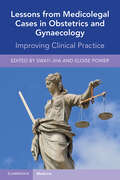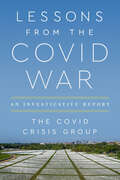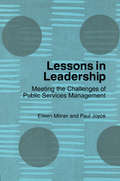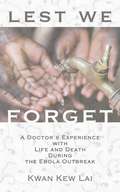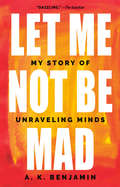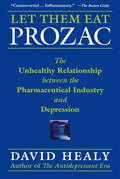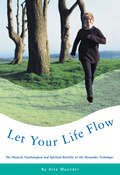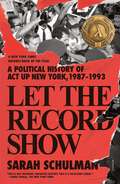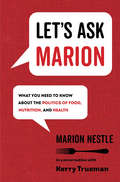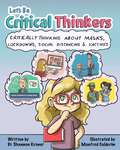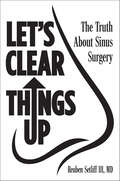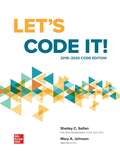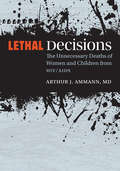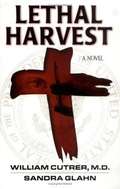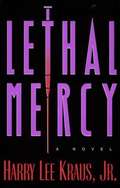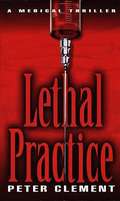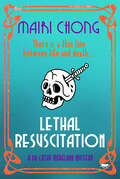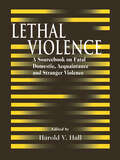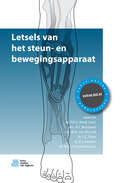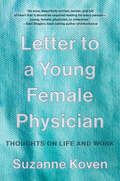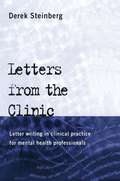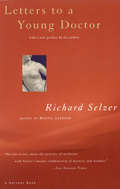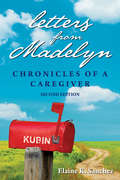- Table View
- List View
Lessons from Medicolegal Cases in Obstetrics and Gynaecology: Improving Clinical Practice
by Swati Jha Eloise PowerObstetrics and gynaecology is the biggest area of medical litigation, with compensation pay-outs exceeding the rest of medicine combined. Many specialists working in the field will be sued over their professional lifetime - having an increased awareness of past cases and their implications will reduce the risk of future litigation. Using landmark cases in the field, this book covers scenarios such as multiple pregnancy, hysterectomy and breech delivery, describing factors that have led to litigation. Chapters are structured clearly, beginning with case commentaries detailing both a successful and unsuccessful claim. This section is followed by legal commentary explaining the relevant laws and the verdict, finally giving a clinical commentary provided by experts in the field which focuses on best practice to avoid litigation. Edited by an accredited expert witness in the field and a barrister specialising in medical law, this is an invaluable resource for clinicians and lawyers alike.
Lessons from the Covid War: An Investigative Report
by Covid Crisis GroupThis powerful report on what went wrong—and right—with America&’s Covid response, from a team of 34 experts, shows how Americans faced the worst peacetime catastrophe of modern times Our national leaders have drifted into treating the pandemic as though it were an unavoidable natural catastrophe, repeating a depressing cycle of panic followed by neglect. So a remarkable group of practitioners and scholars from many backgrounds came together determined to discover and learn lessons from this latest world war. Lessons from the Covid War is plain-spoken and clear sighted. It cuts through the enormous jumble of information to make some sense of it all and answer: What just happened to us, and why? And crucially, how, next time, could we do better? Because there will be a next time. The Covid war showed Americans that their wondrous scientific knowledge had run far ahead of their organized ability to apply it in practice. Improvising to fight this war, many Americans displayed ingenuity and dedication. But they struggled with systems that made success difficult and failure easy. This book shows how Americans can come together, learn hard truths, build on what worked, and prepare for global emergencies to come. A joint effort from: Danielle Allen • John M. Barry • John Bridgeland • Michael Callahan • Nicholas A. Christakis • Doug Criscitello • Charity Dean • Victor Dzau • Gary Edson • Ezekiel Emanuel • Ruth Faden • Baruch Fischhoff • Margaret &“Peggy&” Hamburg • Melissa Harvey • Richard Hatchett • David Heymann • Kendall Hoyt • Andrew Kilianski • James Lawler • Alexander J. Lazar • James Le Duc • Marc Lipsitch • Anup Malani • Monique K. Mansoura • Mark McClellan • Carter Mecher • Michael Osterholm • David A. Relman • Robert Rodriguez • Carl Schramm • Emily Silverman • Kristin Urquiza • Rajeev Venkayya • Philip Zelikow
Lessons in Leadership: Meeting the Challenges of Public Service Management
by Paul Joyce Eileen MilnerUsing international case study material, this book examines how ideas of visionary leadership have been developed and discusses their applicability to the public sector. The book covers: the tensions that can arise between administrative/bureaucratic traditions and the leadership styles required today the relationship between political leadership and organizational leadership different approaches that have been adopted by public service leaders in organizations around the globe and their level of success the extent to which existing theories of leadership are appropriate for a new management context. A welcome addition to the current literature, this book will be invaluable reading for students of public administration as well as practitioners and policy makers in the public services.
Lest We Forget: A Doctor's Experience with Life and Death During the Ebola Outbreak
by Kwan Kew LaiIn 2014 after fighting through yards of bureaucratic red tape, leaving her family, and putting her own health at risk in order to help suffering strangers, Kwan Kew Lai finally arrived in Africa to volunteer as an infectious disease specialist in the heart of the largest Ebola outbreak in history. What she found was not only blistering heat, inhospitable working conditions, and deadly, unrelenting illness, but hope, resilience, and incredible courage. Lest We Forget chronicles the harrowing and inspiring time spent serving on the front lines of the ongoing Ebola outbreak—the complicated Personal Protective Equipment, the chlorine-scented air, the tropical heat, and the heartbreaking difficulties of treating patients she could not touch. Dr. Lai interweaves original diary entries to create a gripping narrative about life, death, and human relationships that will leave no reader unmoved. Lest We Forget exposes the raw brutality of Ebola, as well as the chaotic nature of the undersupplied and understaffed health infrastructure in the developing world. At once a memoir of triumphs and failures and a memorial, this book will ensure that the victims of Ebola and the fighters who sought to heal them will not be forgotten.
Let Me Not Be Mad: My Story of Unraveling Minds
by A. K. BenjaminInspired by Dr. A. K. Benjamin's years working as a clinical neuropsychologist at a London hospital, this multilayered narrative interweaves Benjamin's own sometimes shocking personal experiences with those of his mentally disordered patients.What do doctors actually think about when you list your problems in the consulting room? Are they really listening to you? Is the connection all in your head? Every day for ten years--even while his hospital became the set for a reality television series--clinical neuropsychologist A. K. Benjamin confronted these questions, and this book is his attempt to tell the truth about what happens in these rooms in hospitals the world over.What begins as a series of exquisitely observed case studies examining personalities on the brink of collapse soon morphs into a unique work of nonfiction as Benjamin's own psyche begins to twist the story in surprising ways. Blazingly original, Let Me Not Be Mad undermines the authority we so willingly hand over to clinical psychologists as it bears witness to the self-obsession of Western society, and ultimately offers a glimpse of what it might mean to be sane and truly empathetic.Fractured, sad, playful, brilliant, and confrontational, this is a confession by a professional that delves into the heart of the patient-doctor relationship and ultimately finds love. This twisting psychological journey will be read and reread.
Let Them Eat Promises: The Politics of Hunger in America
by Nick KotzGround-breaking history on the politics of hunger in the United States. Kolz asks who is hungry, why, and how can this be changed.
Let Them Eat Prozac: The Unhealthy Relationship Between the Pharmaceutical Industry and Depression
by David HealyA psychiatrist provides an insider account on the controversial use of selective serotonin reuptake inhibitors (SSRIs)Prozac. Paxil. Zoloft. Turn on your television and you are likely to see a commercial for one of the many selective serotonin reuptake inhibitors (SSRIs) on the market. We hear a lot about them, but do we really understand how these drugs work and what risks are involved for anyone who uses them?Let Them Eat Prozac explores the history of SSRIs—from their early development to their latest marketing campaigns—and the controversies that surround them. Initially, they seemed like wonder drugs for those with mild to moderate depression. When Prozac was released in the late 1980s, David Healy was among the psychiatrists who prescribed it. But he soon observed that some of these patients became agitated and even attempted suicide. Could the new wonder drug actually be making patients worse?Healy draws on his own research and expertise to demonstrate the potential hazards associated with these drugs. He intersperses case histories with insider accounts of the research leading to the development and approval of SSRIs as a treatment for depression. Let Them Eat Prozac clearly demonstrates that the problems go much deeper than a side-effect of a particular drug. The pharmaceutical industry would like us to believe that SSRIs can safely treat depression, anxiety, and a host of other mental problems. But, as Let Them Eat Prozac reveals, this “cure” may be worse than the disease.
Let Your Life Flow: The Physical, Psychological and Spiritual Benefits of the Alexander Technique
by Alex MaunderA basic definition of the Alexander Technique would be how to perform every activity or maintain every posture with the minimum amount of energy. The Alexander Technique teaches us how to release unnecessary muscular tension and realign the posture as we perform our everyday activities.Over 100 years ago E.M. Alexander pioneered his concept of Body/Mind unity. This is the first book to explain the Alexander Technique in terms of energy flow and how we can direct energy with our thoughts. It is also the first book to look at the psychological and spiritual implications of the Alexander Technique and how we can work with our innate Body Wisdom for inner guidance.
Let the Record Show: A Political History of ACT UP New York, 1987-1993
by Sarah SchulmanA New York Times Book Review Editors' Choice. "This is not reverent, definitive history. This is a tactician’s bible." --Parul Sehgal, The New York Times"A masterpiece of historical research and intellectual analysis that creates many windows into both a vanished world and the one that emerged from it, the one we live in now." --Alexander Chee Twenty years in the making, Sarah Schulman's Let the Record Show is the most comprehensive political history ever assembled of ACT UP and American AIDS activism In just six years, ACT UP, New York, a broad and unlikely coalition of activists from all races, genders, sexualities, and backgrounds, changed the world. Armed with rancor, desperation, intelligence, and creativity, it took on the AIDS crisis with an indefatigable, ingenious, and multifaceted attack on the corporations, institutions, governments, and individuals who stood in the way of AIDS treatment for all. They stormed the FDA and NIH in Washington, DC, and started needle exchange programs in New York; they took over Grand Central Terminal and fought to change the legal definition of AIDS to include women; they transformed the American insurance industry, weaponized art and advertising to push their agenda, and battled—and beat—The New York Times, the Catholic Church, and the pharmaceutical industry. Their activism, in its complex and intersectional power, transformed the lives of people with AIDS and the bigoted society that had abandoned them. Based on more than two hundred interviews with ACT UP members and rich with lessons for today’s activists, Let the Record Show is a revelatory exploration—and long-overdue reassessment—of the coalition’s inner workings, conflicts, achievements, and ultimate fracture. Schulman, one of the most revered queer writers and thinkers of her generation, explores the how and the why, examining, with her characteristic rigor and bite, how a group of desperate outcasts changed America forever, and in the process created a livable future for generations of people across the world.
Let's Ask Marion: What You Need to Know about the Politics of Food, Nutrition, and Health (California Studies in Food and Culture #74)
by Marion Nestle"There is no one better to ask than Marion, who is the leading guide in intelligent, unbiased, independent advice on eating, and has been for decades."––Mark Bittman, author of How to Cook Everything Let’s Ask Marion is a savvy and insightful question-and-answer collection that showcases the expertise of food politics powerhouse Marion Nestle in exchanges with environmental advocate Kerry Trueman. These informative essays show us how to advocate for food systems that are healthier for people and the planet, moving from the politics of personal dietary choices, to community food issues, and finally to matters that affect global food systems. Nestle has been thinking, writing, and teaching about food systems for decades, and her impact is unparalleled. Let’s Ask Marion provides an accessible survey of her opinions and conclusions for anyone curious about the individual, social, and global politics of food.
Let's Be Critical Thinkers: Critically Thinking About Masks, Lockdowns, Social Distancing & Vaccines
by Dr. Shannon KronerLet's Be Critical Thinkers is a captivating book designed to equip young minds with essential critical thinking skills to help them navigate today's world. Darlene Data is an aspiring investigative journalist who embarks on a journey to uncover the truth about pandemic policies like those mandating masks, lockdowns, social distancing, and vaccines. Through her adventures, young readers will learn to question propaganda, embrace diverse perspectives, understand the value of scientific research, and recognize the importance of informed consent. Join Darlene on her investigative journey and gain the tools to think critically and ask bold questions—because the truth matters! Spark your imagination with fun activities at the end of the book! Grab your crayons and markers and let your creativity soar!
Let's Clear Things Up: The Truth About Sinus Surgery
by Reuben Setliff IIILearn the facts about sinus surgery and the medical and minimally invasive procedures available to you from a pioneer in otolaryngology. Sinuses. Everybody has them. Nobody likes them. The words &“sinus&” and &“issues&” are associated together so often, it&’s no wonder that over half a million people receive sinus surgery in the US each year. But for many, the problems with their sinuses still persist well after receiving treatment. With more than thirty years of experience as a sinus surgeon, Dr. Reuben Setliff wants patients to know as much as possible about their sinuses when facing the potentially life-altering choices of surgery and picking a long-term care routine. His tell-all book, Let&’s Clear Things Up, explains the differences between optional and necessary surgery, the benefits of minimally invasive procedures, and natural ways to correct sinus problems all on our own. Get informed so that when you walk into a clinic, the air between you and your doctor is clear enough to get you breathing right the first time.
Let's Code It! 2019-2020 Code Edition
by Shelley Safian Mary Elizabeth JohnsonLet’s Code It! provides a 360-degree learning experience for anyone interested in the field of medical coding, with strong guidance down the path to coding certification.Theory is presented in easy-to-understand language and accompanied by lots of examples.Hands-on practice is included with real-life physician documentation, from both outpatient and inpatient facilities, to promote critical thinking analysis and evaluation.This is in addition to determination of accurate codes to report diagnoses, procedures,and ancillary services. All of this is assembled to support the reader’s development of a solid foundation upon which to build a successful career after graduation. The Safian/Johnson Medical Coding series includes the following products: Let’s Code It! ICD-10-CM Let’s Code It! ICD-10-CM/PCS Let’s Code It! Procedure You Code It! Abstracting Case Studies Practicum, 3e The different solutions are designed to fit the most common course content selections. Let’s Code It! is the comprehensive offering with coverage of ICD-10-CM, ICD-10-PCS,CPT, and HCPCS Level II.
Lethal Decisions: The Unnecessary Deaths of Women and Children from HIV/AIDS
by Arthur J. AmmannThis first-person account by one of the pioneers of HIV/AIDS research chronicles the interaction among the pediatric HIV/AIDS community, regulatory bodies, governments, and activists over more than three decades. After the discovery of AIDS in a handful of infants in 1981, the next fifteen years showed remarkable scientific progress in prevention and treatment, although blood banks, drug companies, and bureaucrats were often slow to act. 1996 was a watershed year when scientific and clinical HIV experts called for treating all HIV-infected individuals with potent triple combinations of antiretroviral drugs that had been proven effective. Aggressive implementation of prevention and treatment in the United States led to marked declines in the number of HIV-related deaths, fewer new infections and hospital visits, and fewer than one hundred infants born infected each year.Inexplicably, the World Health Organization recommended withholding treatment for the majority of HIV-infected individuals in poor countries, and clinical researchers embarked on studies to evaluate inferior treatment approaches even while the pandemic continued to claim the lives of millions of women and children. Why did it take an additional twenty years for international health organizations to recommend the treatment and prevention measures that had had such a profound impact on the pandemic in wealthy countries? The surprising answers are likely to be debated by medical historians and ethicists.At last, in 2015, came a universal call for treating all HIV-infected individuals with triple-combination antiretroviral drugs. But this can only be accomplished if the mistakes of the past are rectified. The book ends with recommendations on how the pediatric HIV/AIDS epidemic can finally be brought to an end.
Lethal Decisions: The Unnecessary Deaths of Women and Children from HIV/AIDS
by Arthur J. AmmannThis first-person account by one of the pioneers of HIV/AIDS research chronicles the interaction among the pediatric HIV/AIDS community, regulatory bodies, governments, and activists over more than three decades. After the discovery of AIDS in a handful of infants in 1981, the next fifteen years showed remarkable scientific progress in prevention and treatment, although blood banks, drug companies, and bureaucrats were often slow to act. 1996 was a watershed year when scientific and clinical HIV experts called for treating all HIV-infected individuals with potent triple combinations of antiretroviral drugs that had been proven effective. Aggressive implementation of prevention and treatment in the United States led to marked declines in the number of HIV-related deaths, fewer new infections and hospital visits, and fewer than one hundred infants born infected each year. Inexplicably, the World Health Organization recommended withholding treatment for the majority of HIV-infected individuals in poor countries, and clinical researchers embarked on studies to evaluate inferior treatment approaches even while the pandemic continued to claim the lives of millions of women and children. Why did it take an additional twenty years for international health organizations to recommend the treatment and prevention measures that had had such a profound impact on the pandemic in wealthy countries? The surprising answers are likely to be debated by medical historians and ethicists. At last, in 2015, came a universal call for treating all HIV-infected individuals with triple-combination antiretroviral drugs. But this can only be accomplished if the mistakes of the past are rectified. The book ends with recommendations on how the pediatric HIV/AIDS epidemic can finally be brought to an end.
Lethal Harvest (Bioethics Series #1)
by Sandra Glahn William CutrerThe present and the future collide in this riveting medical thriller torn from today's headlines. Personal faith is forced to confront a lethal combination of blind ambition, scientific risk, and political intrigue. Guaranteed fiction!
Lethal Mercy
by Harry Lee Kraus Jr.When Sarah Hampton dies suddenly at an alternative health center, her death is ruled a suicide and her surgeon-husband, Jake, is suspected of assisting her. Suffering from traumatic amnesia and having barely escaped standing trial for murder, Jake is plagued by public misconceptions, self-doubt, and the threats of an unknown stalker. Maybe he did kill his wife!
Lethal Practice (Dr. Earl Garnet Medical Mystery #1)
by Peter ClementLETHAL DISCOVERY St. Paul's Hospital. Buffalo, New York. Scandal rocks the medical community when someone murders the chief administrator, plunging a long thin cardiac needle into his heart with deadly precision. LETHAL PURSUIT Top ER physician Earl Garnet is one of the few doctors who knows how to insert a cardiac needle. Now a suspect, Garnet races to uncover the truth, even as he becomes embroiled in a conspiracy far bigger and more sinister than he could ever imagine... a secret that could blow apart the very medical establishment Garnet has sworn to serve.... Lethal Practice As a former ER physician at a big city hospital, Dr. Peter Clement brings gripping authenticity to this chilling novel of medical suspense. An explosive mix of technical expertise and grisly murder makes this heart-pounding novel one of the most shocking thrillers of the year. Look in the Bookshare collection for more mysteries in the Dr. Earl Garnet Medical Mystery series.
Lethal Resuscitation (The Dr. Cathy Moreland Mysteries)
by Mairi ChongA medical conference becomes a murder scene, in this mystery starring a doctor in rural Scotland by the author of Shooting Pains. Dr. Cathy Moreland welcomes the chance to stay at a country hotel for an advanced life support course. But the atmosphere among her fellow practitioners seems fraught with tension—and the equipment meant for saving lives is instead used to kill a bad-tempered doctor. He will not be the only one to die—and when Cathy discovers that intimidating notes were being sent to the attendees, including one that calls Cathy herself out for an unethical act in the past, she must find out who may have broken an oath to do no harm . . .
Lethal Violence: A Sourcebook on Fatal Domestic, Acquaintance and Stranger Violence
by Harold V. HallLethal Violence: A Sourcebook on Fatal Domestic, Acquaintance and Stranger Aggression applies the lethal violence sequence analysis to a wide-ranging array of fatal aggression, resulting in a multitude of observations and principles of violence. This sourcebook provides base rate information and cases for each type of fatal interaction, then applies the knowledge to violence-related situations and settings.
Letsels van het steun- en bewegingsapparaat
by P.R.G. Brink A. T. Besselaar J.B.A. van Mourik F. C. Öner K. J. Ponsen R.K.J. SimmermacherBij de diagnostiek en behandeling van pati#65533;nten met letsels aan het steun- en bewegingsapparaat kunnen diverse medische disciplines betrokken zijn. Behalve chirurgen, orthopeden en artsassistenten kunnen ook huisartsen, fysiotherapeuten, gipsverbandmeesters en verpleegkundigen met deze pati#65533;nten worden geconfronteerd. In dit boek wordt een groot aantal letsels van het steun- en bewegingsapparaat besproken, zowel van het skelet als van de weke delen. Per letsel wordt informatie aangereikt over: ongevals-mechanisme; klinische presentatie; diagnostiek; classificatie of typeindeling; conservatieve en/of operatieve behandelingsmogelijkheden; eventuele valkuilen bij diagnostiek en therapie; complicaties en moment van contro≤ te verwachten genezingsduur en prognose. In deze nieuwe druk van Letsels van het steun- en bewegingsapparaat is, met een verjongde auteurssamenstelling, de diepgang van diverse hoofdstukken vergroot. Enkele hoofdstukken zijn totaal herschreven, andere op detailniveau aangepast, en osteoporose heeft een prominente plaats in de behandeling van letsels gekregen. Belangrijk in de lay-out zijn een totale vernieuwing van de tekeningen en het toepassen van een steunkleur. Door het hand-zame formaat en de overzichtelijke indeling kan men in dit rijk ge#65533;llustreerde boek zeer snel de gewenste informatie vinden. De auteurs zijn allen, hetzij als chirurg, hetzij als orthopeed, verbonden aan een Nederlands ziekenhuis. Zij hopen met dit boek bij te dragen aan een verdergaande protocollering van de diagnostiek en therapie van traumatische letsels van het steun- en bewegingsapparaat. Aan deze druk is alleen de toevoeging StudieCloud gedaan. De inhoud is ongewijzigd. In StudieCloud vindt u extra oefenopgaven en daarnaast is het gehele boek online te lezen. Kijk voor het boek online met oefenvragen op StudieCloud. >
Letter to a Young Female Physician: Notes From A Medical Life
by Suzanne KovenA poignant and funny exploration of authenticity in work and life by a woman doctor. In 2017, Dr. Suzanne Koven published an essay describing the challenges faced by female physicians, including her own personal struggle with "imposter syndrome"—a long-held secret belief that she was not smart enough or good enough to be a “real” doctor. Accessed by thousands of readers around the world, Koven’s “Letter to a Young Female Physician” has evolved into a deeply felt reflection on her career in medicine. Koven tells candid and illuminating stories about her pregnancy during a grueling residency in the AIDS era; the illnesses of her child and aging parents during which her roles as a doctor, mother, and daughter converged, and sometimes collided; the sexism, pay inequity, and harassment that women in medicine encounter; and the twilight of her career during the COVID-19 pandemic. As she traces the arc of her life, Koven finds inspiration in literature and faces the near-universal challenges of burnout, body image, and balancing work with marriage and parenthood. Shining with warmth, clarity, and wisdom, Letter to a Young Female Physician reveals a woman forging her authentic identity in a modern landscape that is as overwhelming and confusing as it is exhilarating in its possibilities. Koven offers an indelible account, by turns humorous and profound, from a doctor, mother, wife, daughter, teacher, and writer who sheds light on our desire to find meaning, and on a way to be our own imperfect selves in the world.
Letters From the Clinic: Letter Writing in Clinical Practice for Mental Health Professionals
by Derek SteinbergIn every field of therapeutic practice a significant amount of time is spent writing letters about and to patients. In Letters From the Clinic Derek Steinberg applies detailed literary and psychological analysis to over 40 letters, highlighting why certain words or phrases were used, how they could have been put better, and builds around them principles and theoretical positions based on narrative therapy, consultative approaches and the psychological impact of words and phrases.Using the context of child, adolescent and family psychiatry, while also applicable to all therapeutic work, the book deals with issues such as* explaining clinical conditions and treatments* confirming clinical contracts* conveying difficult advice and painful news* missed appointments and other practicalitiesEach letter is followed by detailed annotations and discussion.Letters From the Clinic will prove a valuable tool to all those working in clinical and therapeutic practice.
Letters To A Young Doctor
by Richard SelzerHighly candid, insightful, and unexpectedly humorous essays on both the brutality and the beauty of the profession in which saving and losing lives is all in a day’s work. A timeless collection by the “best of the writing surgeons” (Chicago Tribune). With a Preface written by the Author especially for this edition.
Letters from Madelyn: Chronicles of a Caregiver
by Elaine SanchezMadelyn Kubin is a 70-year-old Kansas farm wife. She appears to be fragile because of her thinning white hair, macular degeneration, osteoporosis, congestive heart failure, and severe hearing loss. But when her husband Quentin suffers a debilitating stroke, she is forced to summon all of her physical, emotional, and spiritual strengths in order to care for him at home.Madelyn manages her isolation, loneliness, and stress by going to her computer, disengaging her emotional monitor, and writing letters to her daughter Elaine.Madelyn's story of faith, courage, and love is told through her unflinching honest and surprisingly funny letters written in real time over the course of six-and-a-half years. Although she prays ever day that she will be a willing channel for God's love and compassion, there are plenty of days she feels like telling God to go find himself another servant. Madelyn writes unabashedly about her anger, guilt, depression, and grief. When Quentin displays dementia-related inappropriate sexual behavior, Madelyn eventually learns how to handle it with grace and humor. She shows how it is possible, even in the very worst end-of-life situations, to experience mental and spiritual growth.
